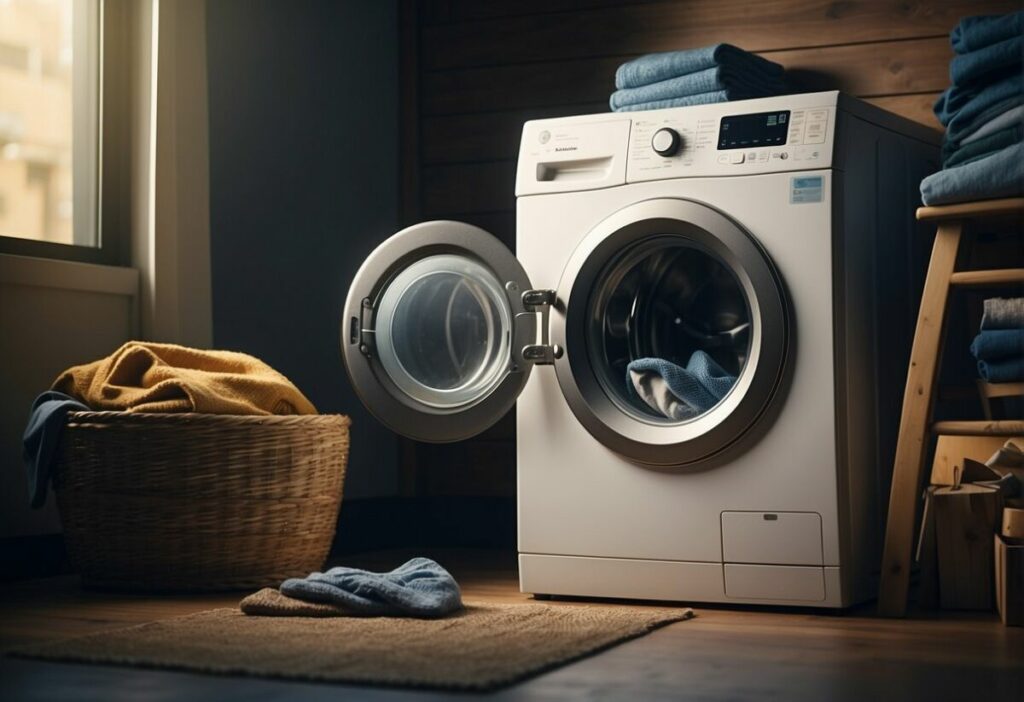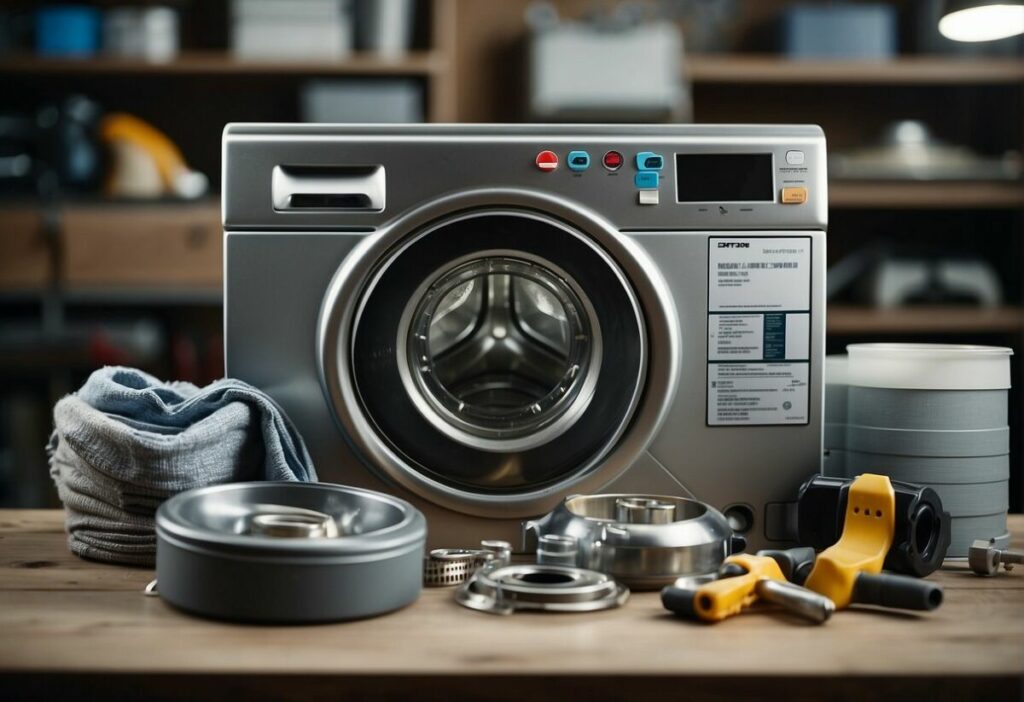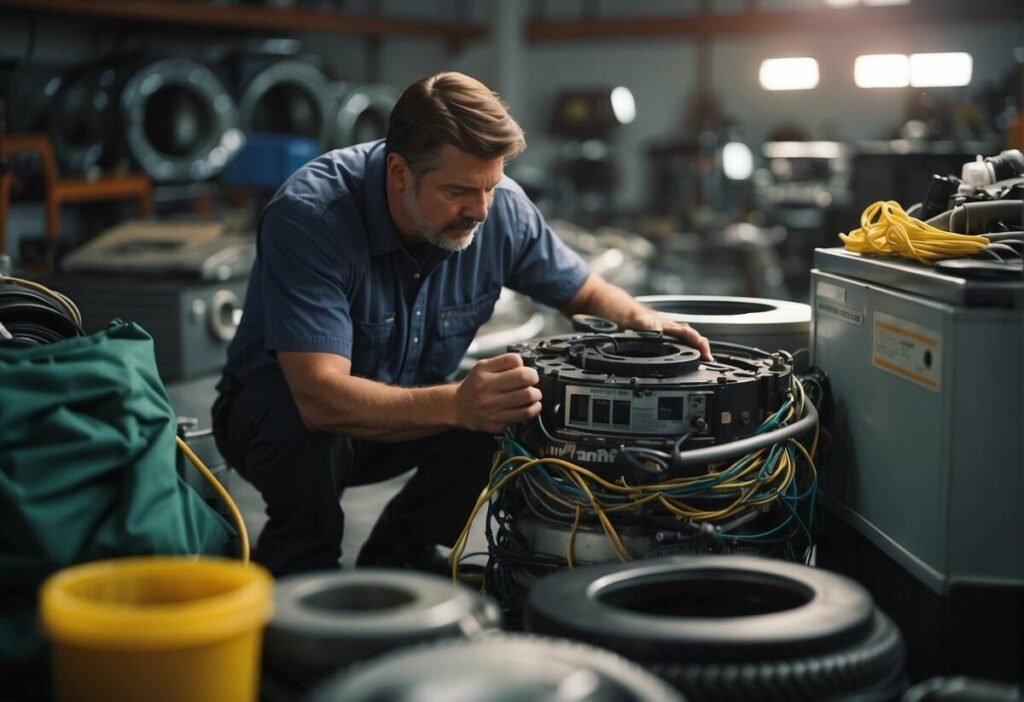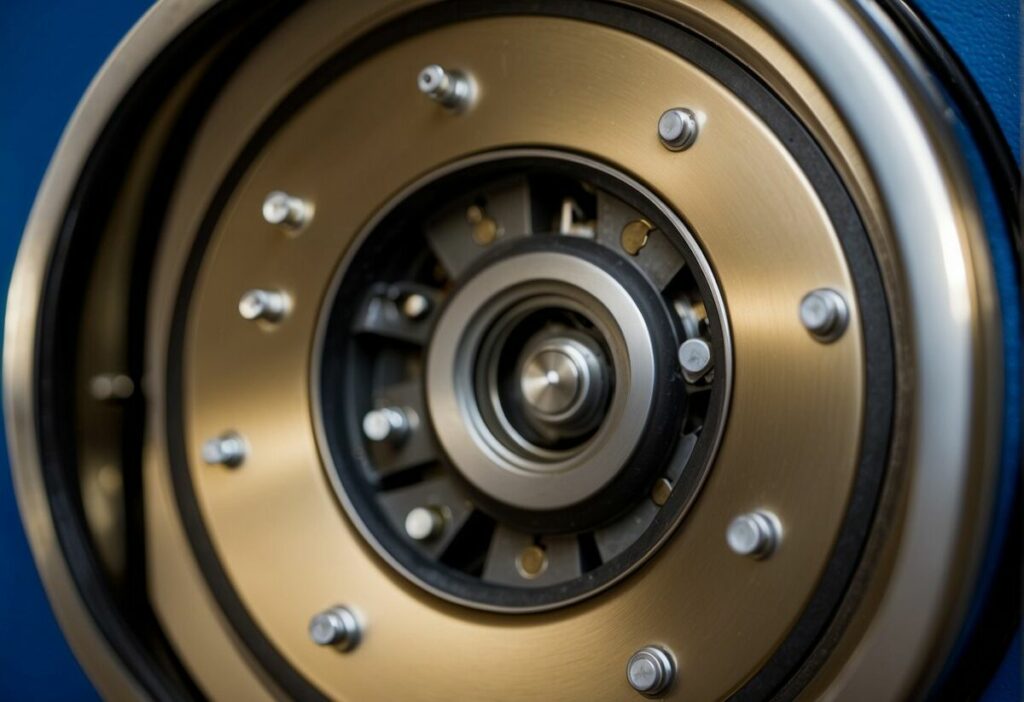A washing machine that isn’t spinning can be a significant inconvenience. When laundry day comes around, homeowners depend on their washing machines to operate smoothly, providing clean and spun-dry garments. However, there are several reasons a washer might stop spinning, ranging from simple overloading of the drum to more complex mechanical failures. Understanding these potential problems is the first step in troubleshooting and restoring the washer’s functionality.

The issues that lead to a washing machine not spinning often involve the balance and distribution of the laundry inside the drum. An uneven load can cause the machine to become unbalanced, preventing it from reaching the necessary spin speeds. Moreover, certain power or mechanical problems could also be the culprits, such as faulty lid switches, worn-out drive belts, or blocked water pumps. Addressing each of these factors is crucial in diagnosing and resolving the root cause of the spinning issue.
Some malfunctions may be remedied with a quick fix, like rearranging the clothing or clearing a filter, while others might require more technical solutions involving component replacements. Only through a methodical approach can one identify whether the situation calls for a do-it-yourself fix or professional intervention. For a washer that won’t spin, the first step is to verify power cord integrity and settings before moving on to more involved checks and repairs.
Common Causes of a Washer Not Spinning
When a washer ceases to spin, several common issues could be at fault. Identifying the right one is crucial for effective troubleshooting and repair.
Overloaded Drum
An overloaded drum can prevent a washer from spinning. Users should ensure they are filling the machine with the appropriate amount of laundry as recommended by the manufacturer.
Unbalanced Load
Items that clump together cause an unbalanced load and can stop the drum from spinning evenly. Redistributing or removing some items can solve this issue.
Faulty Lid Switch
The washer’s lid switch ensures the lid is closed during operation. If this switch is faulty, the machine will not spin as a safety precaution.
Malfunctioning Door Latch
Similarly, front-loading washers have a door latch that must engage properly. If the latch is malfunctioning, the spin cycle may not initiate.
Worn Drive Belt
The drive belt is crucial for movement. A worn drive belt will slip or break, hindering the washer’s capacity to spin.
Defective Motor Coupler
Top-loading washers use a motor coupler to connect the motor to the transmission. If the coupler is defective, it will require replacement to restore the spinning function.
Troubleshooting Steps
When a washing machine fails to spin, it can be due to various issues ranging from simple fixes to more complex mechanical problems. This section provides a systematic approach to diagnosing and solving spinning issues with your washer.
Check Power Supply
Ensure the washing machine is properly plugged in and that the electrical outlet is functioning. A tripped circuit breaker or blown fuse can prevent the machine from operating.
Inspect Washer Door
Front-loading washers will not spin if the door is not securely closed. Check for any obstructions that may prevent the door from closing fully.
Examine Drive Belt
A damaged or loose drive belt is a common culprit for a washer that won’t spin. Inspect the belt for wear and tension, and replace it if necessary.
Test the Lid Switch
For top-loading machines, a faulty lid switch can halt the spinning cycle. Press and release the switch to ensure it’s clicking and that it’s not loose or broken.
Verify Washer Settings
Incorrect settings can affect the spin cycle. Confirm that the washer is set to a cycle that includes spinning and that the settings are appropriate for the load size and type.
Reset the Washer
Sometimes, simply resetting the washer can resolve spinning issues. Unplug the washer, wait one minute, and then plug it back in to reset the system.
Check for Error Codes
Many modern washers display error codes that can diagnose specific problems. Refer to the washer’s manual and resolve any error codes that are shown.
DIY Repair Guide
When a washer stops spinning, it’s often because of a worn-out drive belt, a damaged motor coupler, an inoperative lid switch, or a faulty door latch. Here’s a straightforward guide to fixing these common issues.
Replacing the Drive Belt
The drive belt connects the motor to the drum. Over time, it can wear out or break, leading to a washer that won’t spin. To replace the drive belt:
- Unplug the washing machine. Safety first.
- Access the belt by removing the back panel or the access panel underneath the machine, depending on your model.
- Inspect the belt for wear or damage.
- If needed, remove the old belt and install a new one, ensuring it’s snug around the pulleys.
Fixing the Motor Coupler
The motor coupler is a part that connects the motor to the transmission. If it fails, the washer will not spin or agitate. To fix the motor coupler:
- Disconnect the washer from its power source.
- Remove the cabinet or service panel to access the motor coupler.
- Examine the motor coupler and replace it if it shows signs of wear or damage.
Lid Switch Replacement
A defective lid switch can prevent a washer from spinning because the machine does not detect the lid as closed. To replace the lid switch:
- Ensure the appliance is unplugged.
- Locate the lid switch beneath the top panel.
- Remove the old switch and attach the new one, making sure it’s correctly aligned and secured.
Door Latch Repair
The door latch ensures that the door is sealed during operation. If the latch is broken, the washer won’t start the spin cycle. To repair the door latch:
- Turn off the power to the machine.
- Access the door latch by removing the front panel.
- Replace the faulty latch with a new one, ensuring it clicks into place properly.
By following these steps, individuals can address issues related to a washer not spinning and restore their appliance’s functionality.
Professional Repair and Services

When a washing machine fails to spin, it can be due to complex issues that require professional attention. Service technicians are trained to handle a variety of mechanical and electrical problems that are beyond the scope of typical DIY fixes.
When to Call a Technician
A washer may need a technician’s expertise when it exhibits certain symptoms, such as excessive noise, failure to drain, water leakage, or total non-operation. Complex issues, like a faulty control board or a failed motor, signify the need for a specialist.
Costs of Professional Repair
The price for professional washer repair can vary widely based on factors such as brand, model, and the specific repairs needed. A typical repair may cost anywhere from $100 to $300. Labor costs are generally charged by the hour and can add to the expense, especially for intricate repairs, such as fixing or replacing a damaged drive belt.
Finding a Qualified Technician
To ensure quality and reliable service:
- Check for certifications and licenses.
- Read reviews from previous customers.
- Ensure they have experience with your brand and model.
- Verify warranty terms for the repair services.
Selecting a technician with a proven track record can help ensure your washer is repaired effectively and efficiently, minimizing the risk of recurrent issues.
Preventive Maintenance Tips

To ensure the longevity and proper functioning of your washing machine, it’s important to undertake regular preventive maintenance. Consistency in these efforts can mitigate issues with the spin cycle and extend your appliance’s life.
Load Balancing Education
Understanding how to properly balance a load can significantly reduce strain on the washer’s drum and motor. An unbalanced load can cause the washer to spin unevenly or not at all. It is recommended to evenly distribute items and avoid overloading.
Regular Inspection and Cleaning
Regular inspection of the washer’s interior and components can prevent residue build-up and identify wear before it leads to malfunction. They should clean the drum, seals, and gaskets monthly to keep them free of debris that could cause issues.
Periodic Parts Check
A washer consists of several parts that can wear down over time, such as belts, hoses, and filters. Homeowners should check these parts periodically. For instance, inspecting the drive belt for fraying or looseness can be critical – a worn belt can affect the washer’s ability to spin.
Proper Usage Practices
Adherence to manufacturer guidelines for detergent use and cycle settings helps prevent mechanical and software issues. Excessive detergent can lead to buildup that hampers performance, while incorrect settings can overload the washer’s system, impeding the spin cycle.
Understanding Washer Mechanics

Modern washing machines are engineered with complex systems to ensure clothes are thoroughly cleaned and prepared for drying. A clear understanding of washer mechanics is essential for diagnosing issues when a washer is not spinning correctly.
Spin Cycle Operation
The spin cycle is a crucial phase in a washing machine’s operation where water is extracted from the clothes by centrifugal force. During this cycle, the drum reaches high rotation speeds, pressing the laundry against the drum walls and forcing out water through the drain system. The exact rpm (revolutions per minute) varies among models but can be significant for effective water extraction.
Components Involved in Spinning
Several key components work in unison to enable a washer’s spin function:
- Motor: Drives the drum to spin at the required speeds.
- Transmission: Transfers power from the motor to the drum.
- Clutch: Engages the transmission to spin the drum.
- Belt and Pulleys: Connect the motor to the transmission to facilitate drum movement.
- Lid Switch: Ensures the lid is closed for safety before spinning.
- Pump: Removes water from the wash drum during and after the spin cycle.
If one of these components fails or malfunctions, it can prevent the washer from spinning. Regular maintenance and timely repairs are necessary to keep the washing machine in optimal condition.
Replacement and Upgrade Options
When a washing machine fails to spin, it may signal that it’s time to consider a replacement or look for models with advanced features that could prevent similar issues in the future.
Considering a New Washer
If repair costs for the current washing machine are high, consumers should evaluate the benefits of purchasing a new washer. They have to weigh factors like the age of the machine, energy efficiency, and the frequency of breakdowns. A new machine could offer long-term savings and reliability compared to the continuous repair of an old one. Related issues like a damaged drive belt may indicate underlying problems that are costly to address, reinforcing the consideration for a new appliance.
Upgrade Features to Look For
When exploring upgrade features in a new washing machine, consumers should prioritize:
- Direct Drive Motor: Offers increased efficiency and durability with fewer moving parts.
- Load-Sensing Technology: Adjusts water levels and movement based on the load size, reducing strain on the machine.
- Increased Spin Speeds: Higher RPMs (revolutions per minute) can extract more water, lessening drying time.
- Smart Connectivity: Gives the ability to monitor and control the washer remotely.
Purchasers are advised to research models with extended warranties and positive consumer reviews to ensure both protection and satisfaction with the new upgrade.